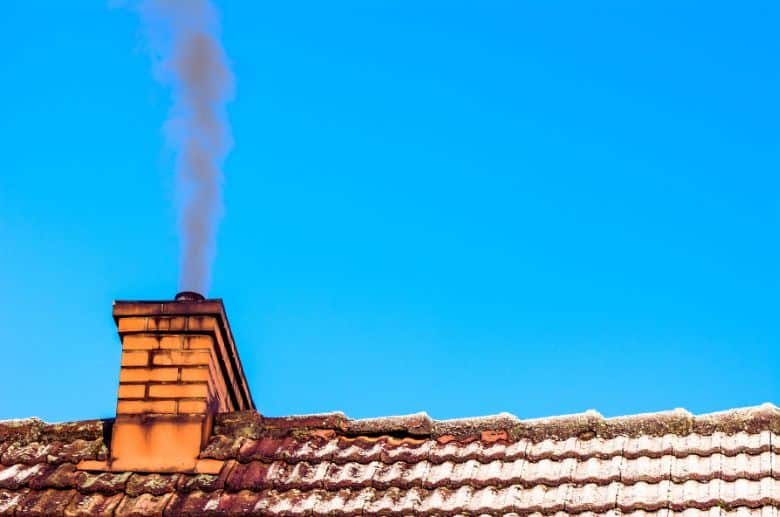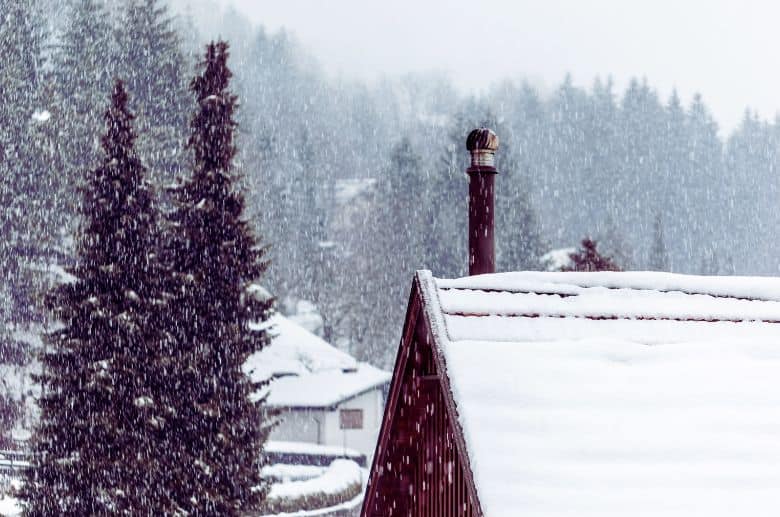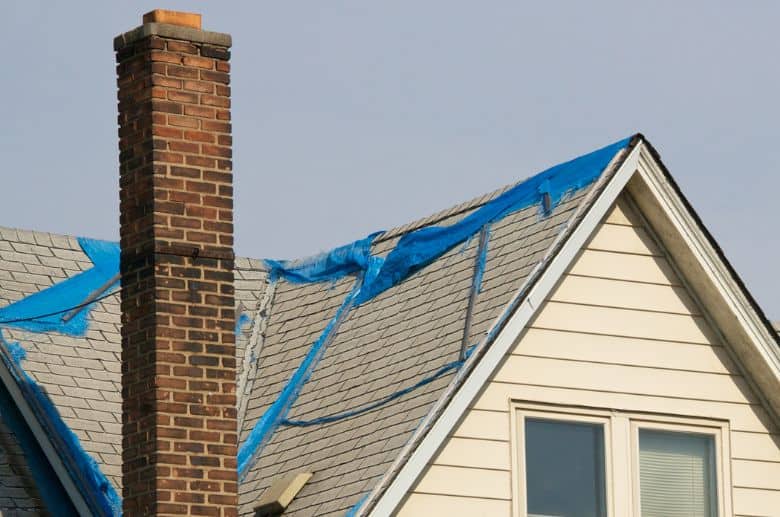It’s a cold winter night, and the only thing that sounds better than curling up in front of a warm fire is curling up in front of that warm fire with a cup of hot cocoa.
So you grab some wood, build a cozy little pile in your fireplace, strike a match, and… nothing happens. No matter how many matches you strike, the wood won’t catch. What’s going on?
The problem might be a chimney not drawing smoke up, perhaps due to a blocked chimney flue. Other issues may include problems with the firebox, an obstructed or closed damper, and creosote buildup.
This post will discuss what homeowners need to know about their chimneys and how to solve these problems efficiently.
How Does Smoke Go Up the Chimney?

Most people have probably noticed that smoke from a chimney always seems to rise straight into the sky. It’s a common misconception that the wind is pulling up the smoke. The reason smoke rises is much simpler: it’s because hot air rises.
The fire heats the air inside a chimney, causing the air to expand and become less dense than the air outside. This difference in density creates a pressure gradient, with the hot air tending to flow towards areas of lower pressure. Occasionally, you might observe white smoke coming out of the chimney, which can be a sign of various conditions inside the chimney or the burning material, but the principle of rising remains the same due to the heat.
Since the atmosphere is mainly made up of air that surrounds the Earth evenly, the only direction for the smoke to flow is upwards. It’s the same process that allows hot air balloons to float.
The next time you see smoke rising from a chimney, remember that nothing is actually propelling it; the smoke simply adheres to fundamental physics laws.
Why Is My Chimney Not Drawing Smoke Up?
A chimney not drawing smoke is a common problem for many homeowners. Below are some reasons why this might happen.
1. The Damper is Closed
One of the most common reasons your chimney might not be drawing smoke is because your damper is closed or partially closed. The damper is what regulates the airflow in and out of your fireplace.
Very little air can flow in when it’s closed, making it difficult for the smoke to escape.
How to Fix
You must open the damper before starting a fire. The most common way to do this is to use a poker or other tool to push the lever that opens the damper.
To operate a top mount damper, you need to:
- Find the knob or lever that controls the damper. This is usually located near the fireplace.
- Open the damper by turning the knob or lever to the “open” position.
- Close the damper by turning the knob or lever to the “close” position.
Top mount dampers are simple to operate and can be a great way to control the airflow in your home. Opening or closing the damper can regulate the heat and smoke entering your living space.
But what happens if you have a throat damper? How do you operate it?
Unlike a top-mount damper, a throat damper is located just below the firebox attached to the smoke chamber. The throat damper’s main purpose is to regulate the amount of air that flows up the chimney.
Here’s how to operate a throat damper:
- Pull the lever on the fireplace’s face to open the throat damper. Some models may have a knob instead of a lever.
- Push the lever or knob in the opposite direction to close the throat damper. It’s important to note that most throat dampers do not seal tightly when closed.
There may be a small gap between the damper and the chimney opening. This is normal and helps to prevent the damper from rusting shut.
If opening the damper doesn’t help, another problem could be at play. Keep reading for more information.
——
Do You Need to Hire Chimney & Fireplace Expert?
Get free quotes from qualified experts near you. No commitment required!
——
2. Insufficient Air Pressure
For a fire to draft appropriately, the room must have ventilation. One common fireplace problem is that many modern homes are sealed a little too well. This means insufficient pressure that prevents the chimney from working properly.
Additionally, the use of exhaust fans in kitchens or bathrooms can exacerbate this problem. When these fans are operational, they may extract air from the home at such a rate that it significantly lowers the interior pressure, resulting in back-drafting.
How to Fix
If you have an exhaust fan in your kitchen, try not to use it while the fireplace is in use. You can also try opening a window or door near the fireplace to help encourage airflow.
Another option is to install a power ventilator near the fireplace. This will help to create the necessary draft to move the smoke out of your home.
If you’re still having trouble, another issue could be at play.
3. The Chimney is Too Short
The taller the chimney, the better it will draft. Heat rises, and the smoke follows the hot air up the chimney.
If your chimney is too short, the smoke won’t have enough time to rise before it cools down and returns to your home.
How to Fix
One ideal solution is to try and rebuild the chimney. This will require a demolition project for professional contractors, but it’s worth it in the long run.
Here are the steps you’ll need to take:
1. Tear down the existing chimney bricks until you reach the roofline.
2. Remove the old mortar and clean up any debris.
3. Lay a new mortar bed on top of the old foundation.
4. Begin rebuilding the chimney using new bricks and mortar. Use fire-resistant materials.
5. Finish by capping off the chimney with a weather-proofing material.
This is a daunting process that will require the services of a professional.
4. Improperly-Built Chimney
Homeowners who discover their chimney is smoky may be dismayed to learn that the problem may be due to poor construction.
Achieving proper drafting in your fireplace and chimney requires hitting a specific mathematical target with the right combination of components.
Sometimes, design flaws in the smoke chamber or firebox cause serious problems that can only be fixed by rebuilding part of the chimney.
How to Fix
If you think your chimney might be poorly constructed, having a professional assess the problem is best. They can provide advice and recommend the best course of action.
In some cases, you can repair the chimney. However, in other cases, it may need to be rebuilt entirely.
5. External Weather Conditions

Since your home’s fireplace flue goes through the roof and outside, sometimes adverse weather conditions can result in smoke filling your house.
Two main weather culprits can cause problems. They include extreme cold and cross-drafting.
Extreme Cold
An unused flue can fill up with cold air in frigid temperatures, and this high-density air blocks the flow of smoke. If your home’s chimney is on an exterior wall, you’re especially susceptible to this problem.
How to Fix
If this happens, try to “warm” your flue by lighting a small newspaper fire at the back of the firebox. Keep feeding the fire more newspapers until the smoke disappears up the flue.
Cross-Drafting
Wind can cause smoke issues in a couple of different ways. The first way is known as Dynamic Wind Loading. When the wind blows against the side of a house, it creates high pressure on that side of the house and low pressure on the other side.
How to Fix
If there is too much pressure on the leeward side of the house, open a window on the windward side to let some air in.
To achieve a more permanent fix, you’ll need to install an outside air kit and tighten up the leeward side of your home.
6. The Height of Your House

A tall chimney is less likely to cause downdrafts, as the taller structure will allow the chimney to extend high enough to reach air with low density.
Not only is your fireplace drafting poorly when your chimney is too short, but the problem gets exponentially worse when strong winds are present. A too-short chimney means improper ventilation and becomes a fire hazard, risking the ignition of your roof.
How to Fix
If you’re developing a chimney for a new home or building, ensure it’s tall enough. If you’re retrofitting an existing chimney, you may need to extend its height.
Adding a chimney cap can also help to increase your chimney’s draft by directing the airflow up and out rather than allowing it to escape sideways.
——
Do You Need to Hire Chimney & Fireplace Expert?
Get free quotes from qualified experts near you. No commitment required!
——
7. Location
The location of your chimney can significantly affect how well it functions.
If the chimney is on the exterior of the home rather than inside of it, then it’s more likely to have chimney draft issues.
A chimney placed in the center of the home will stay warmer than an exterior one. Hence smoke is more likely to go up and out of the house.
How to Fix
Try insulating the chimney or adding a glass fireplace door to fix this issue. Another option is to install a liner in the chimney.
This will create a separate space for the smoke to travel through, which will help to keep the rest of the house warmer.
How to Stop Smoke Coming Down a Chimney?
You can use several ways to prevent smoke from coming down your chimney. Check them out below.
Use a Chimney Cap

A chimney cap is a covering that goes over the top of your chimney. It has several functions. One is to keep out animals and debris.
The other is to create an updraft, which helps pull the smoke up and out of the chimney. You can buy a chimney cap at a hardware store or home center. Ask a pro about the quality and durability to purchase a cap that offers the best results.
Install Draft Guards
Draft guards are devices that fit outside your chimney. They help to seal off any gaps or cracks where smoke might be able to get through.
Draft guards are especially helpful in preventing downdrafts, which can happen when the wind blows from the wrong direction.
Get Your Chimney Cleaned and Inspected Regularly
Cleaning a chimney is a sure way to prevent smoke from coming down the flue. You should have your chimney cleaned at least once a year and more often if you use it frequently. An inspection can also help to identify any problems that need to be fixed.
A professional chimney sweep can clean and inspect your chimney to ensure it is in good working order.
——
Do You Need to Hire Chimney & Fireplace Expert?
Get free quotes from qualified experts near you. No commitment required!
——
Keep Your Home Well-Insulated
Insulating your home will help keep the air inside your home warm, which will help keep the air inside your chimney warm.
Good insulation will also help to reduce your energy bills, so the benefits are a win-win.
Use the Right Firewood
Using dry and seasoned wood is another way to prevent smoke from entering your chimney. Softwoods like pine and cedar produce more creosote, which can build up in your chimney and cause a fire.
Hardwoods like oak and maple burn cleaner and produce less creosote. That means if you want to prevent a smoky chimney, use hardwoods.
These are just a few ways to prevent smoke from entering your chimney. By following these tips, you can enjoy your fireplace worry-free.
What to do If You Can’t Fix Your Chimney That’s Not Drawing Smoke?
If you have a wood-burning fireplace, it’s essential to have a chimney that’s in good working order. Otherwise, you risk carbon monoxide poisoning or even house fires. But what if your chimney isn’t drawing smoke up?
There are a few things that could be causing this problem. It could be that debris, animal nests, or a buildup of soot and creosote block the flue. There might also be an issue with the damper or the fire itself.
Here are some things you can do if your chimney isn’t drawing smoke up:
Step 1. Check the Flue
You should first check the flue to see if it’s blocked. If the flue is blocked, look for the source. In most cases, you’ll need to have it cleaned by a professional service.
Step 2. Check the Damper
The next thing you should check is the damper. The damper is a metal flap that covers the opening of the chimney.
Ensuring the damper is open before you start a fire is essential. Otherwise, all the smoke will go into your home instead of up the chimney.
Step 3. Check the Fire
You can also check the fire itself. Ensure that the wood is dry and that there’s enough of it. If the wood is too green or wet, it won’t burn as well and will produce a lot of smoke.
Step 4. Hire a Professional Chimney Sweeper
If you’ve tried all these things but still experience smoke not going up the chimney, you should consider hiring a licensed professional.
A professional chimney sweeper can help you figure out the problem and how to fix it.
Final Thoughts
If you’re experiencing issues such as smoke not drawing up the chimney, we are here to assist you. Our team of experts can help troubleshoot any problem, big or small.
Moreover, if you seek advice on enhancing the maintenance of your chimney, we invite you to explore our extensive collection of informative articles. These resources provide valuable tips and insights to ensure your chimney receives optimal care.






